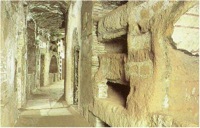Catacombs
Origin
Middle English catacumb, Middle French catacombe, probably from Old Italian catacomba, from Late Latin catacumbae, plural
The first place to be referred to as catacombs was the system of underground tombs between the 2nd and 3rd milestones of the Appian Way in Rome, where the bodies of the apostles Peter and Paul, among others, were said to have been buried. The name of that place in late Latin was catacumbae, a word of obscure origin, possibly deriving from a proper name, or else a corruption of the Latin phrase cata tumbas, "among the tombs". The word referred originally only to the Roman catacombs, but was extended by 1836 to refer to any subterranean receptacle of the dead, as in the 18th-century Paris catacombs.
Definitions
- 1: a subterranean cemetery of galleries with recesses for tombs —usually used in plural
- 2: something resembling a catacomb: as
- a : an underground passageway or group of passageways
- b : a complex set of interrelated things <the endless catacombs of formal education — Kingman Brewster †1988>
Description
Catacombs are human-made subterranean passageways for religious practice. Any chamber used as a burial place is a catacomb, although the word is most commonly associated with the Roman empire. Many are under cities and have been popularized by stories of their use as war refuges, smugglers' hideouts, or meeting places for cults.[1]
